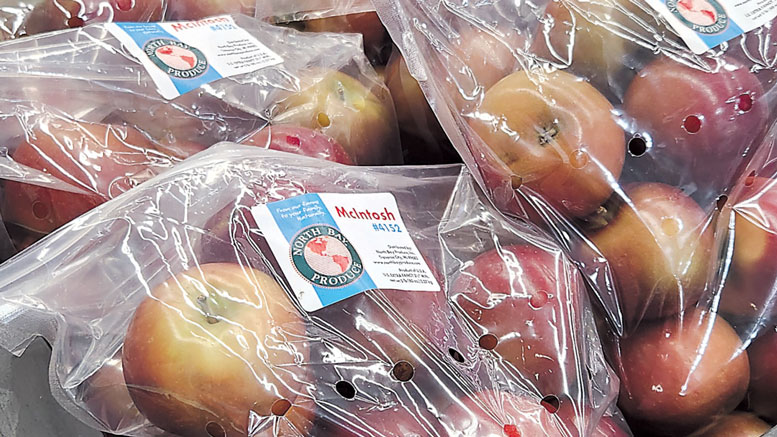Michigan Apple Crop Arrives Early
September 24, 2024 | 9 min to read
The Michigan apple season began two weeks early this year, allowing for a timely marketing push with local Honeycrisps arriving in mid-August. Retailers like Meijer showcase locally grown varieties, labeling them with farm details to boost consumer interest. The state's apples are distributed widely, reaching 32 states and 18 countries, with popular varieties being Honeycrisp, Gala, and Fuji. As demand for local products grows, so does the emphasis on marketing and storytelling to increase consumption.

PRODUCE BUSINESS/AIMEE TENZEK PHOTO
The Michigan apple season is year-round, with each season having its own push.
Due to weather conditions, the Michigan apple crop came in two weeks before the typical date, giving growers a chance at an early marketing push during a year where multiple growing areas have an abundance.
Dani Cavagnaro, manager of produce at Argus Farm Stop, Ann Arbor, MI, notes the early arrival of the apple crop allowed the company to get out ahead of expectations, with local Honeycrisps the first to arrive at the operation in mid-August. As it turns out, that suits the Argus approach to consumer outreach during the fall.
“We wait until we get a really good amount,” she says, which then prompts social media promotion of the local harvest.
“We have an Instagram account and a Facebook page, but Instagram does a better job with this. We will take a picture of the apples and the apple producer and use it, and we also showcase at the stores,” she says

RODUCE BUSINESS/AIMEE TENZEK PHOTO
Among the emerging varieties in Michigan is the Ginger Gold, a yellow variety. But Cavagnaro says the two favorites right now are Honeycrisps and EverCrisps, both varieties developed in the Midwest.
“EverCrisps and Honeycrisps are really popular,” she says, with Argus bringing in “double of everything else.”
LOCAL EMPHASIS
Meijer, a regional chain headquartered in Grand Rapids, MI, with stores from Ohio to Kentucky to Wisconsin, emphasizes local in its stores, online, and in its product lineup.
“As new local apples become available, we bring them on as soon as we can,” says spokesperson Erin Cataldo. “We are carrying five locally grown varieties now, and by mid-September, 75% of our apples will be locally grown.”

PHOTO COURTESY MEIJER
To show off the offering, Meijer introduced new “Fresh from Meijer” packaging for locally grown varieties that includes the name and location of the farm that grew them. “Customers can find this in stores now for Rave, Fuji, Gala and SweeTango,” she says.
Ken Korson, apple category manager, North Bay Produce, Traverse City, MI, says the demand for local, and even regional, apples is a boon to growers in they can get a premium for their fruit.
“It’s really advantageous for us,” he says.
As Argus is an operation that is strictly local in its sourcing, Cavagnaro says there is an ongoing demand for organic apples that it only can source from an orchard almost on the Ohio border “That’s our only option right now,” she says. “We like to have an organic apple.”
DISTRIBUTION FAR AND WIDE
Although the local and regional markets are significant, Diane Smith, executive director of the Michigan Apple Committee, Lansing, MI, says the state’s crop is distributed much further afield, adding Michigan apples are sold in 32 states and 18 countries. “Honeycrisp, Gala, Fuji, and Red Delicious are the most popular, with Gala being the most produced. EverCrisp and Ambrosia continue to gain popularity.”
“Michigan apples are sold in 32 states and 18 countries. Honeycrisp, Gala, Fuji, and Red Delicious are the most popular, with Gala being the most produced.”
— Diane Smith, Michigan Apple Committee, Lansing, MI
From her perspective, Trish Taylor, marketing manager, Riveridge Produce Marketing, Sparta, MI, says Gala, Honeycrisp and Fuji continue to lead the way, with Evercrisp and Ambrosia “gaining attention.”
Korson says North Bay distribution tends to be straight down through the Midwest to points south; east to Pennsylvania; and west to the Rockies.
“West of the Rockies, freight tends to hurt us,” he says. “And we do a lot of business in Florida with the snowbirds from Michigan. They want Michigan apples.”
On a similar note, Taylor says Michigan apples and fresh apple products are most widely distributed east of the Mississippi, with some significant reach into Central America and the Caribbean. “Our Lake Michigan climate for growing tends to give a sweeter profile that many palates appreciate. Michigan cider can be found in all 50 states once the season begins.”
EARLY CROP
North Bay Produce was well prepared at the start of the Michigan apple season. “We completely cleaned up on the old crop, so we were ready,” says Korson. “We’ve probably had our biggest crop.”

PRODUCE BUSINESS/AIMEE TENZEK PHOTO
He adds the Michigan apple crop was “two weeks early out of the gate, which is good for us. The size of the apples is bigger. We’re seeing fruit up one to two sizes, depending on the variety.”
Density of planting is another factor that helps Michigan produce large apples, Korson says.
Still, the unusual weather played a role in the early readiness of the apples that emerged. “This year was abnormal, and I don’t think we’ll see that again with no frost in spring,” he says.
RETAIL PROGRAMS
The Michigan Apple Committee is not an organization that creates and develops retail programs. The focus is on the end user.
“At the Michigan Apple Committee, we are focused on consumer marketing,” says Smith. “Our primary focus is increasing consumption of Michigan apples through a mix of social media, advertising, events and partnerships.”
North Bay works with retailers, providing flavor and variety charts, among other efforts, that retailers can use as visual elements and guides in their merchandising.
“We kick off the first week of September with ads to start getting people excited,” says Korson. “It goes really big in October for Halloween, then through November.”
For Riveridge, social media is an opportunity that supports the work it does with stores.
“We do consumer outreach, particularly in social media and some out-of-home marketing, especially around newer varieties to provide an education on their desirable attributes,” Taylor says. “We often work with retailers to complement their initiatives.”
“Our approach is education,” she adds. “We like to show behind the scenes and the realness of what goes into bringing apples to a store. These can be photos, videos, or simple written content that is direct and rarely polished to be authentic.”
The Michigan Apple Committee has launched a back-to-school campaign, says Smith, which it plans to follow with new initiatives slated for the next several months.
“Consumer excitement for apples increases significantly in September and October, so we like to leverage that excitement by providing as much content as possible to encourage consumption,” says Smith.
As Meijer suggests, packaging can be an important vehicle in getting and keeping consumer attention.
“With retailers moving to private label, brand has less of a chance to reach consumers,” says Taylor. “However, packaging provides the opportunity to be the variety’s billboard. Overall, we want to increase consumption, and help consumers make healthier choices.”
Although harvest time is typically “apple time,” consumers can enjoy Michigan apples long after the last fruit is plucked from the trees.
“Michigan apples are available nearly year-round, and our marketing efforts are also year-round, but as I mentioned, we definitely like to tap into the existing consumer enthusiasm for the product during harvest,” says Smith, “especially here in Michigan, where apples and apple products are an ingrained part of the culture in autumn.”
To maximize outreach efforts, taking the long view is important for the Michigan apple industry, Taylor says,
“The Michigan apple season is year-round and each season has its own push, whether it be the taste of fall to winter apples to cider being a healthier alternative to some beverages,” she says.
It’s important to keep the drum beating for Michigan apples, says Smith.
“Marketing Michigan apples is always a big deal for us, as we combat declining consumption of fruit in the U.S. We need to continue to remind consumers about the myriad benefits of eating Michigan apples, as well as the great flavor and variety available.”
• • •
Michigan Apple Crop Above Average for 2024
On May 19, the Michigan Apple Committee, Lansing, MI, officially announced the crop estimate was 30.5 million bushels, above average for the state’s apple growers.
The committee says Michigan harvested 31.9 million bushels of apples in 2023, citing U.S. Department of Agriculture numbers, with 2022 also seeing a heavy crop. The average crop size is about 25.9 million bushels. The Michigan apple industry has more than 14.9 million trees in commercial production, covering 34,500 acres on 775 family-run farms in Michigan.
“It is unusual to have three large crops in a row,” says Diane Smith, executive director of the Michigan Apple Committee. “However, as growers continue to plant high-density orchards and adopt other innovative growing practices, Michigan’s apple crop sizes will increase, and we will continue to see these larger crops.”
With warmer-than-normal temperatures in late winter and early spring, buds formed ahead of schedule, leading to earlier bloom in May. Over the next weeks, growers didn’t have to deal with significant frost and freeze events, so the early bloom produced a plentiful crop and the harvest took off about 10 days earlier than usual.
“Michigan apple growers share a common goal of producing flavorful, high-quality apples,” says Smith. “They work with tree fruit researchers to implement the latest growing techniques and use new technology to monitor growing conditions. Michigan growers are committed to bringing the best quality fruit to the consumer.”
• • •
Michigan Apple Committee Working With Brand Agency
The Michigan Apple Committee recently hired FoodMix Marketing Communications, an independent full-service food and beverage branding agency, to implement branding, consumer marketing, and social media work aimed at boosting consumption of Michigan apples.
“Michigan Apple Committee is committed to aiding the profitability and sustainability of Michigan’s Apple industry,” says Diane Smith, executive director of the Michigan Apple Committee, Lansing, MI. “One of the ways we do that is through consumer marketing and communication that develops loyalty to the Michigan apples brand, and ultimately increases consumption of Michigan-grown apples.”
FoodMix’s mission is to help brands build meaningful relationships with people through the art of creative storytelling.
“Michigan apples provide consumers all the attributes they want and love from a produce brand. As the Michigan Apple Committee turns its focus toward driving awareness and demand, it is our job to get the authentic and compelling story out and make connections with future brand lovers,” says Dan O’Connell, founder and chief executive of FoodMix.
Michigan apples have gotten a good reception on several social media platforms, where they have been reaching and attracting a target audience that makes food purchasing decisions. Instagram and Pinterest have been identified as key platforms, and a TikTok account launched in early 2022.
2 of 30 article in Produce Business September 2024

